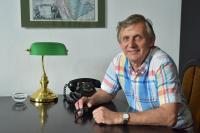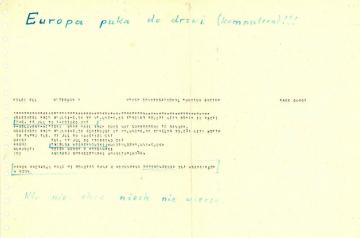A small step for a man and a great leap for information society
He dreamed of becoming an astronaut and exploring outer space, bit by bit. This dream did not come true, he has managed to go down in history nevertheless. Precisely, the history of the Polish Internet. On the anniversary of sending the first Polish e-mail we interviewed Tadeusz Węgrzynowski, head of the Telecommunications Section at the Warsaw University of Technology.
In terms of technological development year 1990 seems almost as distant as prehistoric times.
I am an Electronics graduate and I still find it unbelievable that we have made so much progress. When I recall how much trouble we had with, for instance, cleaning the contacts, discs of low capacity... This is really nothing short of a miracle! [Tadeusz Węgrzynowski points at the smartphone recording our conversation (ed.)].
Your e-mail was, however, a sign of modernity coming our way.
My trip to Copenhagen was planned to last only two weeks – I was supposed to establish contacts and also learn how to administer the system. I had a great partner at the other end, Andrzej Smereczyński, an excellent system and programming expert, who had earlier gone to Paris to learn how to manage this kind of node. It was quite a project. Before we started our work we had to obtain connection from the Polish Post to Copenhagen.
Why was precisely this city chosen?
Denmark was simply open to cooperation and we, people from behind the Iron Curtain, wanted to prove that we were reliable and eager to develop.
You said that as a boy you had dreamed of landing on the Moon. Do you see your travel 30 years ago as a mission comparable to the one by Neil Armstrong?
The scope is different, of course, but to an extent this is an appropriate metaphor. I started my travel from a place with outdated infrastructure and I landed in a reality with supercomputers. A leader with a pager beeping to inform of any failures was at that time an amazing thing to see. It was a completely different world to me. However, my Moon was not Copenhagen but Poland. We had great aspirations but we were equipped with computers that could hold only 3MB of data. Law, economy and technology were not on our side. So the real challenge started really after our return, I felt I was responsible for introducing and maintaining this whole new infrastructure.
Surely positive emotions prevailed.
The administrator of the Danish network was a thoroughly bored man, he did everything automatically. To me, everything I encountered there was a novelty. I was 33, I was enthusiastic and ready to act.
How did sending the first e-mails look like?
We used ordinary phone landlines but with appropriate, verified parameters. At that time the capability was 9600 bytes per second. The development of electronic mail was determined by the limitations of connections. Our Guidelines specified that e-mails should not be more than 500 Kb as otherwise it would create too much of a burden. And there was no spam whatsoever, because all users were aware of these limited capabilities. Spam appeared around 1993
With the professional work and the development of the telecommunications industry we needed to keep track of all modern solutions applied worldwide
I worked with European research institutions and telecommunications operators under the programme titled Information society technologies. Every year I attended conferences as an expert responsible for evaluation of ICT projects. In 1992, I was invited to visit several American universities, including the MIT. There, I realised that some people speak the same language, even if they come from very different places. English had become the language of the IT industry, obviously, but it was also the language of innovation and competitiveness that I noticed.
The experience gained during these trips and during your work at the University of Warsaw turned out to be helpful after your return to your Alma Mater.
The Warsaw University of Technology faced a challenge and I decided to take up the glove. A university located within old buildings requires constant modernisation of its network. Will 5G be the solution with which we will be able to join various systems? How will all this look like in 20 years? No one knows. In the past replacing the monitors with the LCD seemed like a luxury and then it became just a necessity. Who knows what kind of changes are ahead of us? Maybe the next epoch-making discoveries will be a result of chance. As in the case of Jan Czochralski who put the pen nib into the pot with melted tin and realised that he had created a monocrystalline.
You seem to be still fascinated with the academic work.
It’s true, I like my job. However, sometimes I need something completely different to take my mind off of it. Running marathons gives me a sense of freedom, a passion I have managed to pass to some of my colleagues. My family sometimes protests against it because I run without much training, but I do feel free then. And 20 years younger.
Read about Tadeusz Węgrzynowski and the story behind the Copenhagen project also in the article from our archive, the Research – Innovation – Technologies series.









